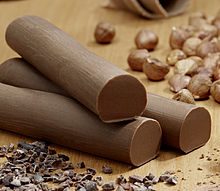
Chocolate, or cocoa, is a food made from roasted and ground cacao seed kernels that is available as a liquid, solid, or paste, either on its own or as a flavoring agent in other foods. Cacao has been consumed in some form for at least 5,300 years starting with the Mayo-Chinchipe culture in what is present-day Ecuador. Later Mesoamerican civilizations also consumed chocolate beverages before being introduced to Europe in the 16th century.

Nutella is a brand of brown, sweetened hazelnut cocoa spread. Nutella is manufactured by the Italian company Ferrero and was introduced in 1964, although its first iteration dates to 1963.

A chocolate bar is a confection containing chocolate, which may also contain layerings or mixtures that include nuts, fruit, caramel, nougat, and wafers. A flat, easily breakable, chocolate bar is also called a tablet. In some varieties of English and food labeling standards, the term chocolate bar is reserved for bars of solid chocolate, with candy bar used for products with additional ingredients.

Icing, or frosting, is a sweet, often creamy glaze made of sugar with a liquid, such as water or milk, that is often enriched with ingredients like butter, egg whites, cream cheese, or flavorings. It is used to coat or decorate baked goods, such as cakes. When it is used between layers of cake it is known as a filling.

Milk chocolate is a form of solid chocolate containing cocoa, sugar and milk. It is the most consumed type of chocolate, and is used in a wide diversity of bars, tablets and other confectionery products. Milk chocolate contains smaller amounts of cocoa solids than dark chocolates do, and contains milk solids. While its taste has been key to its popularity, milk chocolate was historically promoted as a healthy food, particularly for children.

Dutch processed cocoa, Dutch cocoa, or alkalized cocoa, is cocoa solids that have been treated with an alkalizing agent to reduce the natural acidity of cocoa, giving it a less bitter taste compared to "natural cocoa" extracted with the Broma process. It forms the basis for much of modern chocolate, and is used in ice cream, hot chocolate, and baking.
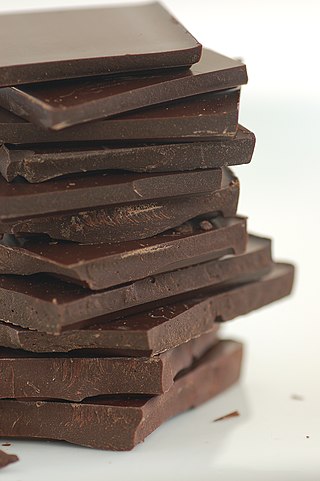
A chocoholic is a person who craves or compulsively consumes chocolate. The word "chocoholic" was first used in 1961, according to Merriam-Webster. It is a portmanteau of "chocolate" and "alcoholic". The term is used loosely or humorously to describe a person who is inordinately fond of chocolate; however, there is medical evidence to support the existence of actual addiction to chocolate. Psychoactive constituents of chocolate that trigger a ‘feel-good’ reaction for the consumer include tryptophan and phenylethylamine, which may contribute to cravings and addiction-like responses, particularly in people with specific genetic alleles. The quantity of sugars used in chocolate confections also impacts the psychoactive effects of chocolate.
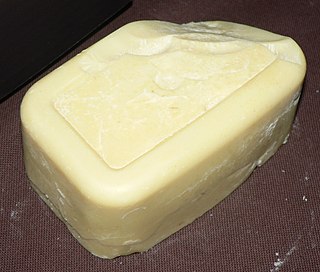
Cocoa butter, also called theobroma oil, is a pale-yellow, edible fat extracted from the cocoa bean. It is used to make chocolate, as well as some ointments, toiletries, and pharmaceuticals. Cocoa butter has a cocoa flavor and aroma. Its melting point is slightly below human body temperature. It is an essential ingredient of chocolate and related confectionary products. Cocoa butter does not contain butter or other animal products; it is vegan.

White chocolate is a confectionery typically made of sugar, milk, and cocoa butter, but no cocoa solids. It is pale ivory in color, and lacks many of the compounds found in milk, dark, and other chocolates. It is solid at room temperature because the melting point of cocoa butter, the only white cocoa bean component, is 35 °C (95 °F).

Maltesers are a British confectionery product manufactured by Mars, Incorporated. First sold in the UK in 1937, they were originally aimed at women. They have since been sold in Europe, Australia, New Zealand, Canada, United States and Middle East. The slogan is "The lighter way to enjoy chocolate".
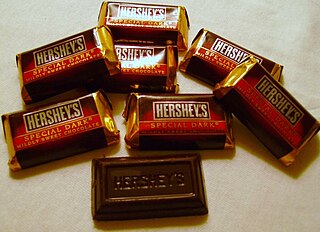
Hershey's Special Dark is a chocolate bar manufactured by The Hershey Company.

Milk Duds are a brand of candies made with chocolate, created in 1928 by Hoffman and Company of Chicago and now produced and marketed by The Hershey Company, under license from owners of the brand, Highlander Partners, a Dallas-based global private equity firm.

Couverture chocolate is a chocolate that contains a higher percentage of cocoa butter (32–39%) than baking or eating chocolate. This additional cocoa butter, combined with proper tempering, gives the chocolate more sheen, a firmer "snap" when broken, and a creamy mellow flavor.
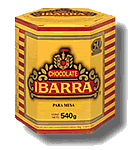
Ibarra is a brand of Mexican chocolate para mesa, produced since 1925, and since 1954 produced by the company Chocolatera de Jalisco of Guadalajara, Jalisco, Mexico. The company manufactures other chocolate products, but Ibarra table chocolate is its best-known product, with presence throughout Mexico as well as international markets, mainly in the Americas, but also in parts of Europe.

Big Turk is a candy bar manufactured by Nestlé in Canada, that consists of dark magenta Turkish delight coated in a chocolate coating.

Polyglycerol polyricinoleate (PGPR), E476, is an emulsifier made from glycerol and fatty acids. In chocolate, compound chocolate and similar coatings, PGPR is mainly used with another substance like lecithin to reduce viscosity. It is used at low levels, and works by decreasing the friction between the solid particles in molten chocolate, reducing the yield stress so that it flows more easily, approaching the behaviour of a Newtonian fluid. It can also be used as an emulsifier in spreads and in salad dressings, or to improve the texture of baked goods. It is made up of a short chain of glycerol molecules connected by ether bonds, with ricinoleic acid side chains connected by ester bonds.

Hershey Kissables were a chocolate candy sold by The Hershey Company from 2005 to 2009. Comparable to M&M's, Hershey Kissables were shaped like miniature Hershey's Kisses and were coated in a thick sugar shell.

Dry cocoa solids are the components of cocoa beans remaining after cocoa butter, the fatty component of the bean, is extracted from chocolate liquor, roasted cocoa beans that have been ground into a liquid state. Cocoa butter is 46% to 57% of the weight of cocoa beans and gives chocolate its characteristic melting properties. Cocoa powder is the powdered form of the dry solids with a small remaining amount of cocoa butter. Untreated cocoa powder is bitter and acidic. Dutch process cocoa has been treated with an alkali to neutralize the acid.
The following outline is provided as an overview of and topical guide to chocolate:

Dark chocolate is a form of chocolate containing only cocoa solids, cocoa butter and sugar. Dark chocolate without added sweetener is known as bitter chocolate or unsweetened chocolate. As with the other two main types of chocolate, dark chocolate is used for chocolate bars or as a coating in confectionery.





